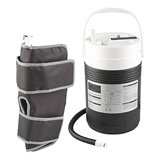Rhinoviruses are estimated to be the culprit for about 35% of these cases. Rhinoviruses belong to a family of viruses known as picornaviridae, which means small RNA viruses. This virus has an icosahedral structure and is about 30 nanometers in diameter, placing rhinoviruses among the smaller viruses. There are over 100 different types of rhinoviruses, which makes developing a vaccine against rhinoviruses difficult.
Transmission
The rhinovirus receives its name because “rhino” means nose, the location where the virus typically infects. The optimal temperature for rhinovirus replication is between 33-35o C, which is about the same temperature found inside of the nose. The virus is spread by direct contact with aerosols produced when someone coughs or sneezes. Rhinoviruses are quite stable and can survive a few hours on an inanimate object, which can lead to infection if transferred to the nose, eyes or mouth. Since the virus is sensitive to pH and temperature, it replicates best below core body temperature and does not survive the acids found in the stomach, which means the virus does not infect the lower respiratory or gastrointestinal tract.
Symptoms
The symptoms of the common cold caused by the rhinovirus can last up to two weeks and include the following: sneezing, stuffy or runny nose, sore throat, coughing, water eyes, mild headache and mild body aches.
Prevention
The best way to prevent rhinovirus infection is to practice good hygiene by washing your hands frequently and avoiding touching your nose, eyes and mouth. Also, when possible, avoid close contact with people who have colds or other upper respiratory infections.
Treatment
Children and adults usually recover from a cold within two weeks. You should always keep your healthcare provider informed if the illness gets worse or lasts longer than expected. Over the counter medicines may help relieve some symptoms but the best way to combat the common cold is to get plenty of rest and drink plenty of fluids.
Research
Scientists have sequenced the complete genomes of 138 different full-length human rhinovirus genomes. This information has been used to discover that there may be 4 different species of rhinovirus. The information gained by these types of studies may prove valuable for developing antiviral medications and vaccines.
Sources:
- NIH Common Cold:
- Understanding the Common Cold
- CDC Common Cold























